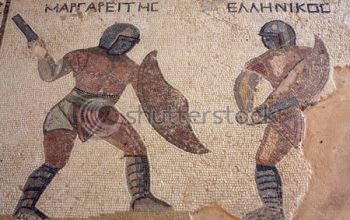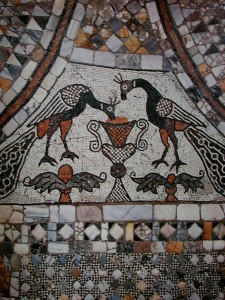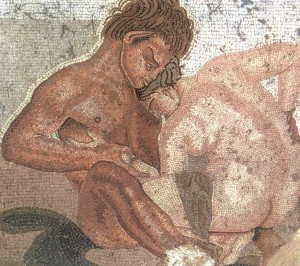Departments
Search
Follow Us
Tags
Latest Highlights
IBH
The History of Mosaic Art
 In its modern form, mosaic means a mixture or montage, a design created by a composite of shapes; but its ancient beginnings are of function and design. Around 3000 B.C., mosaic designs were created with clay cones imbedded, point first, into columns of the Stone Cone Temple in Urak, in Mesopotamia. This ancient cone mosaic art was a predecessor to the glass mosaic art of Egypt, the black and white pebble mosaics in eighth century B.C. Gordium (Gordion, Turkey), and the multi-textured Greek, Roman, Byzantine, and Italian mosaics that followed.
In its modern form, mosaic means a mixture or montage, a design created by a composite of shapes; but its ancient beginnings are of function and design. Around 3000 B.C., mosaic designs were created with clay cones imbedded, point first, into columns of the Stone Cone Temple in Urak, in Mesopotamia. This ancient cone mosaic art was a predecessor to the glass mosaic art of Egypt, the black and white pebble mosaics in eighth century B.C. Gordium (Gordion, Turkey), and the multi-textured Greek, Roman, Byzantine, and Italian mosaics that followed.
Mosaic Art with a Purpose
 The primitive patterned designs of the early cone mosaics added a decorative element to the pillars of ancient buildings, but the cones served another purpose. In Ancient Mesopotamian Materials and Industries: The Archaeological Evidence (Oxford: Clarendon Press, 1994), P. Roger S. Moorey—British archeologist and historian, specializing in the Ancient Near East—wrote, “At Urak, the decorative cone mosaics were particularly applied to free-standing columns and to walls with buttresses and recesses.”
The primitive patterned designs of the early cone mosaics added a decorative element to the pillars of ancient buildings, but the cones served another purpose. In Ancient Mesopotamian Materials and Industries: The Archaeological Evidence (Oxford: Clarendon Press, 1994), P. Roger S. Moorey—British archeologist and historian, specializing in the Ancient Near East—wrote, “At Urak, the decorative cone mosaics were particularly applied to free-standing columns and to walls with buttresses and recesses.”
In citing other resources, Moorey presents evidence that the mosaics were “patterned after rugs and mats hung as decoration on walls,” and that the decorations protected the walls from “wind and water erosion.” Moorey concludes that the cone mosaics, also found at other settlements in Mesopotamia, show that “the intimate relationship of protection and decoration is evident in most uses.”
Egyptian Glass
Small pieces of glass in mosaics were first used by the Egyptians during the New Kingdom (c. 1550 to 1069 B.C.). Very small pieces of dull-colored glass were used to make mosaic jewelry and mosaic stones. The stones were added to wall pieces and inlays, usually in funerary art. It wasn’t until the Roman Empire took control of Egypt in 31 B.C. that glass production would advance to a higher art form in Egypt. With an abundance of sand and soda, and with years of mastering the art, Egypt created much of the glass for the Roman nobles.
Pebble Mosaics and Tesserae
 By the eighth century B.C., mosaics of random patterns were being assembled from black and white pebbles in Gordium (Gordion, Turkey). The pebble mosaics added art and design to an area and provided some protection during inclement weather. Six centuries later, mosaic floors—a precursor to the tile floors of today—were widespread among the Greek nobles. Smooth river rocks, with smaller pebbles used to fill in the gaps and create more detailed designs, were used to form floors and pathways. Mosaic art was further defined with the introduction of tesserae, pieces of stone and glass cut into small squares. These mosaic tiles of small uniform pieces made it much easier to create intricate designs.
By the eighth century B.C., mosaics of random patterns were being assembled from black and white pebbles in Gordium (Gordion, Turkey). The pebble mosaics added art and design to an area and provided some protection during inclement weather. Six centuries later, mosaic floors—a precursor to the tile floors of today—were widespread among the Greek nobles. Smooth river rocks, with smaller pebbles used to fill in the gaps and create more detailed designs, were used to form floors and pathways. Mosaic art was further defined with the introduction of tesserae, pieces of stone and glass cut into small squares. These mosaic tiles of small uniform pieces made it much easier to create intricate designs.
Mosaic Art of the Roman Empire
As the Roman Empire expanded, mosaic art grew with it. The mosaics at Pompeii are an excellent example of the styles and types of designs the Romans preferred. Marble tiles became a popular choice for floor mosaics and styles ranged from geometric patterns to bucolic scenes. An excavation in Antioch (Antakya, Turkey) revealed one of the largest collections of mosaic floors from the second century A.D. Many are on display at the Hatay Archaeological Museum in Antakya.
Byzantine and Italian Mosaics
By the late fifth century, with the fall of the Roman Empire, the Byzantine Empire came into power. With a surge in Christianity, mosaic art turned to religious subjects and the walls of churches, temples, and palaces displayed colorful intricate designs made with smalti, deeply colored glass tiles with uneven surfaces. Smalti were also made with gold and silver leaf, layered between two pieces of glass. While other tesserae were also used, with smalti, the variety of colors and the luster of gold or silver added another dimension to mosaic art.
 During the sixth century, under Emperor Justinian’s rule, the Basilica di San Vitale in Ravenna, Italy, was built with most of its walls and ceiling covered with mosaic art. The town has many other exceptional examples of Byzantine mosaic art and is inscribed on the UNESCO World Heritage List. Rome and Venice are other towns in Italy with excellent examples of mosaic art. The art was popular throughout Italy during the late middle ages.
During the sixth century, under Emperor Justinian’s rule, the Basilica di San Vitale in Ravenna, Italy, was built with most of its walls and ceiling covered with mosaic art. The town has many other exceptional examples of Byzantine mosaic art and is inscribed on the UNESCO World Heritage List. Rome and Venice are other towns in Italy with excellent examples of mosaic art. The art was popular throughout Italy during the late middle ages.
Historic Multicultural Mosaic Art
Mosaic art has a long and varied history, and although it was widely popular in Europe and the Near East, examples of ancient mosaics have been uncovered in China and South America. Mosaics served a purpose of protecting walls and floors from wind and water, as well as adding a decorative element With each advancing civilization, mosaic art advanced with it—from clay stones to colored glass, from smooth river rocks to tesserae and smalti. Today, mosaic art has become even more specialized with varied materials combined in a blending of artistic interpretation.
My Handmade Mosaic’s
 Done in what is called Pique Assiette, which comes from the French language, meaning literally translated “stolen from a plate”. However I have never, ever used a new plate rim, all my mosaics are made from already damaged china plate rims, broken, scratched, cracked, with flea bites, enhanced with colored stained glass and other pretty’s, vintage broken jewels and baubles, handmade clay roses, pearls and such.
Done in what is called Pique Assiette, which comes from the French language, meaning literally translated “stolen from a plate”. However I have never, ever used a new plate rim, all my mosaics are made from already damaged china plate rims, broken, scratched, cracked, with flea bites, enhanced with colored stained glass and other pretty’s, vintage broken jewels and baubles, handmade clay roses, pearls and such.
Tags: art, art history, artistic jewelry, handcrafted, Handmade, Handmade Artists, handmade jewelry, mosaic, mosaics, selling handmade online
Posted in Handmade
4 Responses to “The History of Mosaic Art”
Leave a Reply
You must be logged in to post a comment.


Wonderful piece, Monika! I feel so educated now!!!
Wow makes you feel sort of small with all the history out there. Thanks for sharing
Monika…thank you for all the wonderful history on mosaics!
Super article!!!
Yeah….can you believe how old this art is….and how many different mediums can be used, ach, endless…..